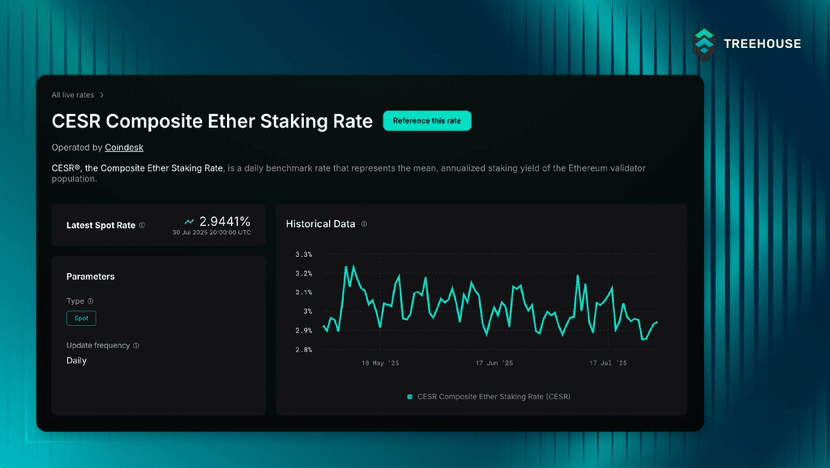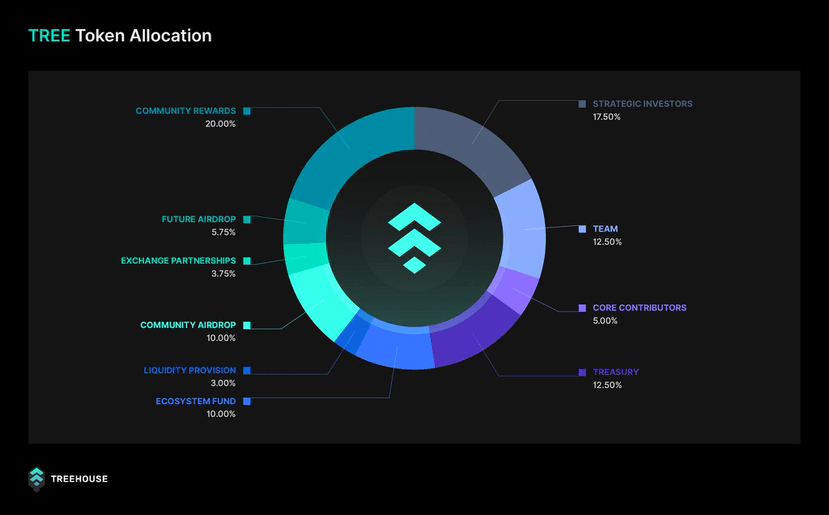Even though the trend is downward, the enthusiasm remains high! It's truly impressive.
In the traditional financial world, gold prices have unified quotations, and bank deposits have benchmark interest rates, which prevent you from 'overpaying' or 'losing out' on savings. However, in DeFi, the annualized interest rates of different protocols vary greatly, with some at 2%, 5%, or even 15%. It seems like there are many opportunities, but in reality, it is difficult to compare, and the authenticity is hard to discern.
Treehouse is here to solve this problem. It aims to be the 'interest standard setter' and 'yield aggregator' in the DeFi world—on one hand, establishing a unified interest rate benchmark, and on the other, efficiently combining fragmented yields to make capital operations more efficient and transparent.
1. Two key components of Treehouse: tAssets + DOR
(1) tAssets automated yield assets
You will deposit ETH or liquid staking tokens (like stETH) into Treehouse's protocol and receive a corresponding tETH.
The tETH behind this is tied to automated arbitrage and yield strategies, such as capturing the price difference between Ethereum staking rates and lending market rates. It's like handing your money over to a savvy financial manager who will automatically move money between different banks and markets to maximize stable returns.
(2) DOR: Decentralized interest rate benchmark
DOR (Decentralized Offered Rate) is the decentralized interest rate quotation system created by Treehouse, equivalent to LIBOR or SOFR in the crypto world.
In this mechanism, multiple independent Panelist nodes provide interest rate recommendations for certain assets (such as Ethereum staking annualized), and then determine a unified reference interest rate through a consensus mechanism, like the Ethereum Staking Rate (TESR).
This way, the interest rates in the DeFi world have an 'authoritative scale', allowing investors and protocol parties to make decisions based on it.
2. TREE token: a triple role within the system
(1) Governance tokens
Users holding TREE tokens can participate in protocol governance, with voting rights on everything from yield strategy adjustments to DOR release processes and fee allocations.
(2) Yield certificates
Panelist nodes supporting DOR require capital endorsement; you can deposit TREE into the 'Pre-Deposit Vault' to support interest rate generation and earn annualized returns (APR) of up to 50%-75%, which is a direct and substantial use of the token.
(3) Payment fuel
Accessing and using DOR data requires payment, and TREE is the medium for this 'service fee'. In other words, as more protocols and institutions reference DOR, the demand for TREE will naturally increase.
Launch performance and market volatility
By the end of July 2025, Treehouse completed its TGE, launching simultaneously on top exchanges like Binance and Coinbase, and airdropped 10% of the token share to the community through the 'GoNuts Season 1' event. Before launch, the protocol's TVL had already surpassed $550 million, showing impressive early recognition.
However, the post-listing trend was like a roller coaster—on the first day, airdrop profit-taking caused a sell-off, and within 24 hours, the price dropped by about 46%. Currently, TREE stabilizes in the $0.43-$0.44 range, with a total market cap of approximately $68 million and a circulation of 156 million tokens, accounting for 15.6% of total supply.
Token release structure and long-term supply-demand
Treehouse's token distribution includes:
Community rewards: 20%
Strategic investors: 17.5%
Team and ecological fund: over 40%, most set with a 48-month lock-up period.
This structure means short-term selling pressure is manageable, but the subsequent unlocking pace will affect price volatility.
Why Treehouse is the 'interest spring' of DeFi
Unified standards: Like the benchmark interest rate for RMB loans, providing authoritative references for DeFi interest rates to reduce chaotic competition.
Automated arbitrage: tETH turns complex yield brick-moving into 'one-click yield', saving users effort and gas costs.
Support for institutional products: DOR provides the foundational data that allows DeFi to launch more fixed-rate and note-like products, attracting institutional capital.
Community participation: TREE holders can earn returns through staking and directly participate in ecological rule-making.
Treehouse is like the 'gold scale + automatic savings machine' of the crypto world
In traditional gold shops, buying and selling gold must be weighed accurately; only then can you trade with peace of mind. Treehouse's DOR is that scale—unified and precise, preventing anyone from using fraudulent interest rates to fool people.
And tAssets are like an automatic savings machine: the money you put in will automatically transfer to accounts with higher interest rates, and it will also deposit the interest into your card daily.
The gold scale allows you to see clearly, and the automatic savings machine helps you earn quickly—only by combining the two can assets be both secure and efficient.
If DOR can be referenced by more DeFi protocols, it may become the 'benchmark anchor' for on-chain interest rates, forming a network effect; the success of tAssets depends on the stability and safety of strategy returns, which, once proven, will create long-tail user stickiness.
Market competition: There are many competitors in the interest rate benchmark and yield aggregation fields, with giants like Curve and Lido possibly entering.
User education: It will take time for ordinary users to understand the value of DOR; initially, it may benefit more institutions and professional players.
Token volatility: The release rhythm of TREE and market sentiment will directly impact its price stability.
If DeFi is likened to a bustling marketplace, Treehouse is like the master with a precise gold scale at the entrance—everyone selling or buying has to weigh their goods first, ensuring fairness and transparency. Its tAssets are like a runner who helps you deliver money to the most profitable stalls, returning daily to report the accounts.
This combination makes Treehouse not just a profit-generating protocol, but also a maintainer of order and a promoter of efficiency in the entire market. For users who value capital safety, transparent returns, and long-term stability, it may become part of the future DeFi infrastructure.


